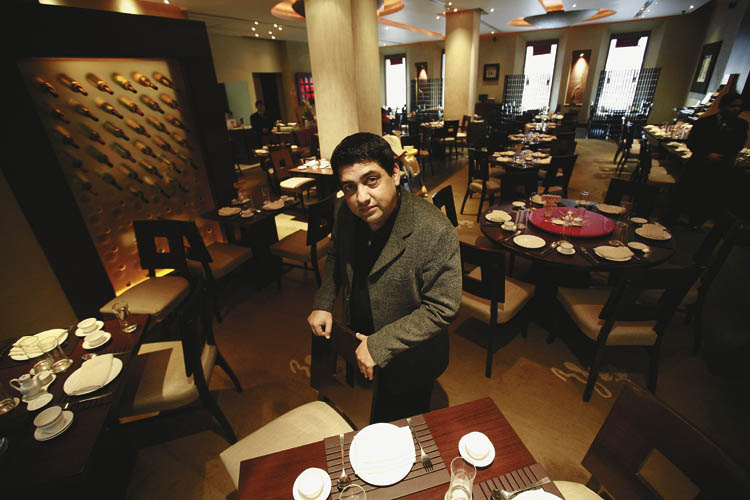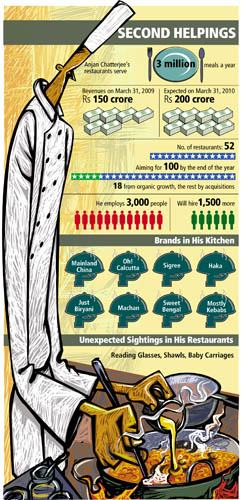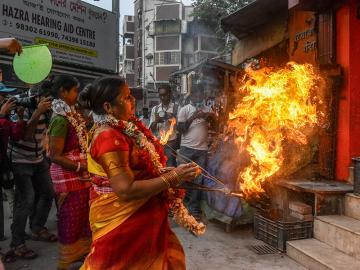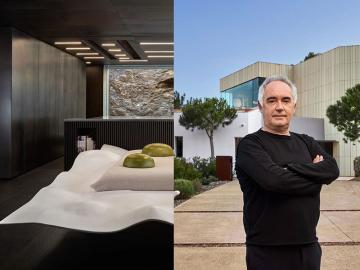
No Wanton Plan, This
Restaurateur Anjan Chatterjee is expanding his restaurant network and betting on the franchisee route. But it will be a tough plan to pull off
When you can choose from an array of reading glasses, ask the maitre d’ for a shawl to keep the cold off or get a bassinet for your baby, you know you have come to a restaurant that is different. This is what makes adman Anjan Chatterjee’s Mainland China food chain thrive among a loyal, growing customer base.
Chatterjee has 52 restaurants (spread across eight brands including Mainland China, Sigree and Oh! Calcutta) across 11 cities including three abroad — Beijing, London and Dhaka. Now he wants to spread to tier-II towns and in some ways be a pan-Indian fine-dining restaurant chain.
Chatterjee’s company Speciality Restaurants Pvt. Ltd. (SRPL) and SAIF Partners (Softbank Asia Infrastructure Fund), an investor in SRPL, are busy scripting the new plan. They are looking at a listing on the stock market next year. It depends on the number of acquisitions. They want to expand the chain to 100 restaurants before the initial public offering. What makes them sure they are ready?
SRPL models itself on P.F. Chang’s China Bistro, a chain of 189 Chinese restaurants in 39 states in the US. That is the scale it wants to achieve. “The key difference between India and the US is that there are dozens of chains [there] that have scaled to over a hundred locations,” says Ravi Adusumalli, general partner at SAIF. “In India, we believe that SRPL will be the first to reach this landmark. Is India ready for 200 Chinese fine-dining restaurants? Probably not. But 200 across four-five brands? Yes.”
SAIF Partners backs Chatterjee’s aggressive strategy. It had bought a 20 percent stake in SRPL for Rs. 90 crore in December 2007 valuing the business at Rs. 450 crore. “Most other chains expand to around five or six outlets and then fail to scale, but SRPL has potential to be the first fine-dining chain to have over 100 outlets. They have demonstrated the ability to scale with the right processes in place,” says Adusumalli.
One thing is sure. Chatterjee’s task is difficult. Think about it. There are hardly any pan-Indian restaurant chains, forget fine-dining. The only company to have done it at any sizeable level is Blue Foods through Copper Chimney, Noodle Bar and Spaghetti Kitchen. The impediments are many. The Indian taste palette varies across regions. Restaurants find it hard to get good real estate. And because the restaurant mortality rate is high, finances to scale up operations is very hard to get.
Add to Taste
That’s not stopping Chatterjee because SRPL has reached a saturation point in the metros and needs to expand. It is aiming for Chandigarh, Ludhiana, Jaipur, Mangalore and Kochi for the next expansion wave. Not all the growth will be organic. Chatterjee is also looking to dilute 10-15 percent of stake in his company to raise funds to acquire a south Indian restaurant chain and an Italian restaurant chain. And to open new restaurants in tier-II towns, he is planning to use the franchise route, where he will provide the cooking methodology and train the staff while the franchisee will bring the space and the investments. Depending on the location, SRPL will take between 11 and 13 percent from the revenue as commission. So if everything goes well, Chatterjee will be looking at 100 restaurants across 10 brands by the year end. That would mean his turnover would almost double from the Rs. 150 crore as on March 31, 2009.
Franchising is difficult in the food business. “Fifty percent of franchisees in India do not match up to the standards of the brands. They begin to cut corners, it could be anything from cutlery to substandard ingredients,” says Nitin Deshmukh, private equity head, Kotak Mahindra.
What if the franchisees don’t match up to SRPL standards? “We are taking the franchise-owned, company-operated route. The brand’s essence is not diluted. Manpower, full training, quality standards and brand standards, everything goes through us,” counters Chatterjee.
Not everyone is convinced. One of the best fine dining restaurants in India, Indigo, just celebrated its 10th anniversary this April. The number of branches it has so far: Three and all are in Mumbai. “I don’t know whether Anjan is making the right decision. But franchising doesn’t work for a fine-dining restaurant. And that has been a problem all over the world. Big chefs have lent their names to restaurants and they have all closed down,” says Rahul Akerkar, managing director of deGustibus Hotels, which owns the Indigo brand.
However, Chatterjee’s strategy receives a thumbs up from Vikram Bakshi, managing director and joint venture partner for McDonald’s India. “The commitment (to a franchise) has to be 100 percent; you cannot treat the business as another business in the portfolio. This existing situation demands that we need to sift the committed entrepreneurs from wannabes; which clearly requires a refocus on education on franchising. Hence, our learning so far clearly indicates that company-operated model delivers, as the focus is long-term.”
Undercooked
A major reason no Indian sit-down restaurant player has scaled up is a lack of processes. The ability to deliver is limited. “In the mid-level to fine-dining restaurant business, you need a system delivered operation. Right now, people don’t have that in place,” says Akerkar.
A restaurant is only as good as its people. Even if one chef or a small team of cooks leaves, the quality of a restaurant could suffer. Employee turnover is quite high in this business. SRPL has opened a catering institute to combat this problem: Mainland Institute of Oriental Catering at Salt Lake, Kolkata, to train and re-train employees according to its specifications. The institute has 250 students. And the place supplies staff to all his restaurants. The training is important for the staff as their appraisals are linked to how well they perform during their training sessions.
Apart from processes, fine-dining restaurants have to deliver an experience rather than just a meal. “If a restaurant can make Rs. 800 on an average bill, then the margins can be 20-25 percent, else they drop to 10-15 percent. Also, very few locations in India are both lunch as well as dinner places. So a restaurant has to make its money from one dining occasion,” says Milind Kothare, CEO, mKons Consulting, a hospitality consulting company.
Till last year, getting high bill values was not that difficult. With the slowdown this year, one of the first things people cut down is eating out. Chatterjee says most visitors to his restaurants have kept coming, though there has been a drop in the corporate business. “Last year, there was madness on corporate tables. In one table, there were five imported wine bottles. The man has got equity, he thinks it’s not my money, it’s the fund’s money, so udao. That mindlessness has stopped,” he laughs.
Getting Them to Pay
Each patron at a Mainland China outlet in Mumbai pays Rs. 425 on an average. This sort of billing enables most of SRPL’s restaurants break even within six to eight months, Rajesh Mohta, general manager for finance and accounts, says. And 80-85 percent of the current restaurants are profitable. Will tier-II towns pay that kind of money?
Indigo’s Akerkar thinks so. “There’s certainly money in tier-II cities. There’s a lot of potential waiting to be tapped. Anjan will have prime mover advantage and if he can maintain his superior quality over time, there’s no reason for him to beat existing restaurants,” he says.
Chatterjee adds, “They will pay for quality. Of course we may have to adjust tastes. But we have done that in metros as well. If we serve slightly thick rice, they say what the ****, we are paying so much money and this! Indians like basmati rice. Basmati ka fried rice, you just can’t change.”
Chatterjee looks for opportunities everywhere. And he tells interesting stories. Sigree, the north Indian chain, actually serves pre-partition era dishes. He picked them up from Gafur miya, a chef in Lahore, when he had gone there for a cricket match. He got the recipe for dab chingri, a dish from Bangladesh, for Oh! Calcutta. “I met a 78-year-old lady in Chittagong, Bangladesh for the recipe. One of the finest moments of my life. This lady at home, someone’s granny, extremely difficult to deal with but she chatted with me and made some dab chingri for me. And it was very important for me. Because after her the recipe will be extinct. No book writes it,” he says.
Years ago, Chatterjee’s Situations Advertising had come up with the Aaya naya Ujala, chaar boondon wala jingle to make the clothes whitener a household name. At the time Ujala was competing with Reckitt and Coleman’s established Robin Blue.
This time Chatterjee has the first mover advantage. He has to replicate his successful model when others are standing still. This has the makings of a very yummy story.
(This story appears in the 31 July, 2009 issue of Forbes India. To visit our Archives, click here.)
-
 Dr. T T PATIL
Dr. T T PATILWe are looking for JV Partner for Fine Dinning Restaururant in Pune/Nasik. we have properties in prime areas. If interested on revenue sharing basis, pl contact 9422331910<br />
on Dec 7, 2009 -
 Gautam
GautamI admire what he's done in building both brand and scale. But let's not kid ourselves, it isn't really authentic Chinese. Not that the market cares but all the same...
on Jul 28, 2009
















